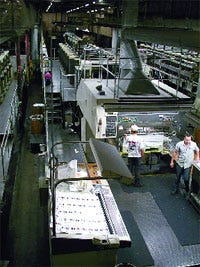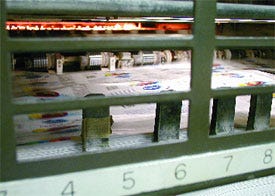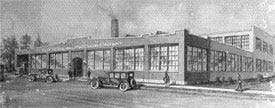January 29, 2014
Pioneering shelf-stable cranberry sauce in the 1930s, Ocean Spray Cranberries, Inc., Lakeville-Middleboro, MA, has a long history of product and packaging innovation. For the 21st century, modifying its canned sauce packaging for flexibility and cost savings involved the use of a flowering new label-printing technology that yielded a greater than anticipated harvest.
In July, 2003, Ocean Spray began the process of having the labels for its canned cranberry sauce converted from a traditional four-color-process-printed design to one using the HiColour™ six-color system. Developed by another industry trailblazer, Fort Dearborn Co., headquartered in Niles, IL, HiColour provides Ocean Spray with the ability to combine its print runs, maximizing production efficiencies and lowering inventory costs. But, one of the most visible advantages of the switch was the transformation of its label graphics from flat to fabulous.
"HiColour adds life, depth and color vibrancy," says Troy P. Reed, senior account manager, Fort Dearborn. "To address the increased shelf appeal and higher-quality graphics, the proof is in the pudding, or sauce, as it were. Compare a conventional sample to a HiColour sample–these are powerful results."
Process enables 1.6 million colors
In mid-2003, Ocean Spray investigated the possibility of saving money by combining the offset printing of its lower-volume sauce-product labels with the larger volume of labels produced for its core sauces. The existing paper labels, adorning 8-, 16- and 55-oz, and #10 cans, were being litho-printed in four-color process plus spot colors, which meant that each stockkeeping unit required a dedicated print run. Totaling 11 skus altogether, the products included items for foodservice and international distribution, which were produced in smaller volumes, and Ocean Spray's higher-volume goods–Whole Berry and Jellied cranberry sauces–in several sizes.
Converting its label artwork to Fort Dearborn's HiColour process allowed Ocean Spray to combine these print runs. And, not only did the conversion not compromise the quality of the graphics, but it actually improved the aesthetic appearance of the packaging.
HiColour, a six-color printing technique imported in the fall of 1997 from FDC Europe, Ltd. (formerly the Springfield Group), a division of Fort Dearborn in Hull, England, is similar to the six-color Hexachrome® process developed by Pantone, Inc., in 1994. However, HiColour has been engineered especially for packaging applications and comprises some key distinctions, including a different screening method and ink set. The most visible difference is the appearance of HiColour's green and orange inks, which lack the fluorescence of Pantone's Hexachrome ink set, making them more suited to food applications.
The HiColour system delivers more than 1.6 million colors, including up to 85 percent of Pantone Matching System (PMS) colors. With this technology, virtually any color that can be displayed on a computer screen or captured on film can be reproduced with ink on paper, as well as on film, plastic and any other substrate that can be litho-printed, according to Reed.
"HiColour makes package design and printing much easier on everyone involved," Reed notes. "From the printer's standpoint, sometimes it's difficult for us to work with designers, because we may get a label that has twenty-eight colors on it, for example. Well, we only have presses with six to eight colors, so we can't print the design, nor could the customer afford it if we could. So the designer ends up having to make sacrifices.
"With HiColour, since we can produce up to eighty-five percent of PMS colors, it's a win/win for everyone. The customer gets the costs they need, and the designer gets their design without having to make compromises."
Process combines prepress, printing
While the additional two colors–green and orange–are central to the HiColour process, implementing the technique involves more than just putting the ink on the paper (or carton or film). Explains Reed: "HiColour is a color management system that closes the loop in the relationship between files, proofs, press conditions and print. All aspects of color are measured and confirmed at every level, providing the ultimate in color consistently. HiColour also expands the reproducible color gamut twofold, which enhances color vibrancy."
To
|
Labels are printed on sheets measuring 35 x 51 in. on a 51-in. press with coating capabilities and automatic color control. |
convert the Ocean Spray labels from traditional four-color process to HiColour, the Fort Dearborn in Elk Grove Village, IL, took existing electronic files and manipulated them using state-of-the-art separation software and Creo's Stacatto® FM (frequency-modulated, or stochastic) screening technology. Stacatto uses extremely small, crisp dots of a uniform size printed in a random pattern to prevent moiré patterns, and it provides remarkable sharpness and definition as well as enhanced reproduction of subtle tones. In addition, with Stacatto, tolerance for lateral registration shifts on-press is increased, making it easier to maintain print consistency from the beginning through to the end of a print run, and from one printing facility to another.
"Further, by coupling our high-definition screening with HiColour printing, you avoid the 'graininess' that results when you try to build a special color out of traditional line screens," adds Reed.
Operating in a purely digital workflow, Fort Dearborn produced the proofs for the Ocean Spray labels using a Kodak Approval XP digital halftone proofing system from Kodak Polychrome Graphics. The proofer has the ability to produce and adjust true halftone dots, and duplicates the density and dot-gain characteristics of the printing press. The system is also capable of printing on a variety of substrates to match the actual print job. In the case of Ocean Spray, the material being used was a 60# C1S label stock supplied by MeadWestvaco and Pasadena Paper.
What really clinched the deal with Ocean Spray, relates Reed, is that "once they compared the proof to the printed labels, HiColour merited their full attention." Upon approval of the proofs, plates were created using a Creo Trendsetter VLF 4557 platesetter, which uses thermal imaging technology to create plates up to 45 x 57 in.
While Fort Dearborn provides complete prepress services for the HiColour process, it has opened the field to other prepress vendors to expand the industry's use of the six-color system. According to Reed, an earlier stumbling block to selling HiColour was the fact that many potential customers had long-term relationships with their prepress suppliers or design firms. "So, no matter how great the system was, we weren't going to get the prepress work, which meant we weren't going to get the print work," he says. Now, through alliances that ensure the integrity of the HiColour system, other firms may supply the prepress work, as long as Fort Dearborn gets the print job.
Six-color yields production efficiency
Printing of Ocean Spray's canned sauce labels in HiColour commenced in August, 2003, at Fort Dearborn's 142,000-sq-ft Fort Worth, TX, facility, a full-service offset label printing division that supplies national and international food, beverage and consumer goods manufacturers with up to eight-color cut-and-stack labels.
Ocean Spray's labels are printed, depending upon order quantities, on either a 40- or a 51-in. Mitsubishi press from MLP USA using inks from Sun Chemical. The two presses are equipped with backside printing units, coating units and ATS (Auto-Tracking Spectrophotometer) color control from X-Rite, Inc. Labels are cut by Polar 155 and 137 cutters from Heidelberg.
According to Reed, since PD last discussed HiColour in depth nearly three years ago (see PD, Jan., '01, p. 72), the percent of sheets produced annually at Fort Dearborn using six-color technology has risen dramatically. In 2002, HiColour comprised 7 percent of the company's sheets, today that number has increased to 20 percent. Part of the increase can be attributed, he says, to Fort Dearborn's efforts to convert as many customers as possible to HiColour. "One reason is Velocity [a program of printing more frequent turns of lower quantities]," he explains. "With Velocity, we will probably be able to get the lead times down to seven days or less, and part of this is HiColour. With HiColour, whenever we change jobs, all we have to do is change plates.
"With conventional four-color process plus spot colors, changing jobs results in a three- to four-hour makeready due to downtime. You have to change plates, clean press units, take out the old ink, put in the new ink. With HiColour, we're more efficient, so we actually achieve greater throughput with less downtime."
Results exceed expectations
In Ocean Spray's case, for a conversion cost of less than $4,000, it can now reduce lead times on its labels by having all them all produced on one press sheet. "Since there are no cost implications, Ocean Spray has reduced its inventory from a ninety-day-plus supply held at both Fort Dearborn and at Ocean Spray's facilities to a forty-five-day or less supply held only at its facilities," Reed explains. "Through Velocity, the company has been able to reduce inventories, and change graphics or promotions and get them to market quicker than before while eliminating obsolescence."
|
After six-color printing and varnish application, label sheets stack up at the end of the press. |
According to Jeana Connolly, packaging procurement, Ocean Spray Cranberries, "the change to HiColour was for printing flexibility, production efficiencies and cost, not necessarily to provide an advantage to the appearance of the labels." However, she notes, while it's too soon to tell what affect the color-enhanced packaging will have on sales, "it would be a bonus" if its new labels planted the seeds of new sales.
More information is available:
HiColour prepress, six-color printing: Fort Dearborn Co., 773/774-4321. www.fortdearborn.com. Circle No. 218.
HiColour development: FDC Europe, Ltd., 011-44-1482-226461. www.fortdearborn.com. Circle No. 219.
Hexachrome, PMS: Pantone, Inc., 201/935-5500. www.pantone.com. Circle No. 220.
Screening technology, platesetter: Creo Americas, Inc., 978/439-7000. www.creo.com. Circle No. 221.
Digital proofer: Kodak Polychrome Graphics, 203/845-7000. www.kpgraphics.com. Circle No. 222.
Label stock: Pasadena Paper Co., 888/493-2525. www.pasadenapaper.com. Circle No. 223.
Label stock: MeadWestvaco Corp., 203/461-7400. www.meadwestvaco.com. Circle No. 224.
Presses: MLP USA, Inc., 847/634-9100. www.mlpusa.com. Circle No. 228.
Inks: Sun Chemical Corp., 201/224-4600. www.sunchemicalink.com. Circle No. 229.
Spectrophotometer: X-Rite, Inc., 800/248-9748. www.xrite.com. Circle No. 230.
Cutters: Heidelberg USA, Inc., 888/472-9655. www.heidelbergusa.com. Circle No. 231.
Printer stands strong after 78 years | ||
Fort Dearborn Co. was founded in the Chicago area more than 75 years ago by Nick Adler Jr. In 1925, having recently finished a printing apprenticeship in Milwaukee, Adler gambled on his newly acquired skills, using his life savings of $6,000, along with a matching loan from his father, to open a one-press printshop in Niles, IL, about 15 miles north of Chicago. He named the company after what had been the best-equipped U.S. government outpost in the Midwest during the 1800s–Fort Dearborn–and, according to company lore, vowed to build a business that would live up to its namesake.
By 1930, Fort Dearborn Co. had begun carving its niche in label production for food and beverage products. In 1963, son Tom took over the reigns of the company, which continued to excel in the production of cut-and-stack labels for the canned food industry. Since the 1960s, Fort Dearborn has expanded exponentially through acquisitions and organic growth. |
Ocean Spray thrives on innovation since 1930Agricultural cooperative Ocean Spray, which today is owned by more than 800 cranberry growers and 126 grapefruit growers located throughout the U.S. and Canada, was formed in 1930 by three cranberry growers who shared a common desire to expand the market for their crops. Led by lawyer and cranberry grower Marcus L. Urann, who had perfected a shelf-stable cranberry sauce, the cooperative sought to develop innovative products made from cranberries.
In 1930, Ocean Spray became the first producer of cranberry juice drinks with the introduction of Cranberry Juice Cocktail. In 1963, the company revolutionized the marketplace, introducing the first juice blend, Cran•Apple™ cranberry apple juice, which became such a huge sensation that the cooperative added new flavors to the line.
In 1976, Ocean Spray expanded its membership to include grapefruit growers from Florida's Indian River region. Ocean Spray® Grapefruit Juice quickly became the number-one bottled grapefruit juice in the country, says the company, followed by Ocean Spray® Pink Grapefruit Juice Cocktail, the very first citrus blend of its kind. In 1991, Ocean Spray introduced what became the most popular beverage from the company up to that point, Ocean Spray® Ruby Red Grapefruit Juice Drink.
Another hallmark of Ocean Spray's history is its packaging innovation, including its introduction in the U.S. in 1981 of aseptic packaging. Now a popular mainstay in the juice section, "juice boxes" first appeared on store shelves as Ocean Spray® Paper Bottle™ juice containers. In 1985, Ocean Spray became the first manufacturer to package juice drinks in polyethylene terephthalate bottles. The cooperative later introduced a gallon PET bottle with convenient side handle, which was recognized with the prestigious DuPont Award in 2000 (see PD, Feb., '00, p. 44).
In 1995, innovative cranberry products took on a whole new wrinkle when Ocean Spray introduced Craisins® sweetened dried cranberries, which quickly became a snacking and cooking favorite. In 2001, the entire line of Ocean Spray products was launched with the first major label redesign since the 1970s. Also in 2001, Ocean Spray introduced the White Cranberry Juice Drink line.
In 2002, tiny bubbles meant big news as Ocean Spray launched Juice Spritzers, a line of single-serve carbonated juices. That year, Ocean Spray also launched its entire line of 64-oz juices in a new rectangular-shaped bottle, designed to be easier to hold, easier to pour and best of all, to fit easily in refrigerator doors (see PD, Oct., '02, p. 2).
Always in step with the trends of the times, in 2003, Ocean Spray took four favorite juice flavors and launched convenient multipacks of portable plastic bottles, for families on-the-go.
About the Author(s)
You May Also Like





